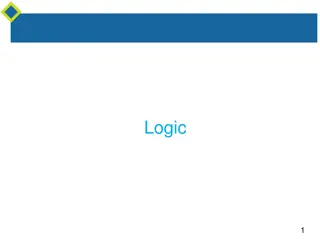
Enhancing Network Security with Web Application Firewalls (WAF) and Defensive Network Design
Explore the role of Web Application Firewalls (WAF) in safeguarding web applications against cyber threats like SQL injection, XSS, and DDoS attacks. Learn about implementing a robust network defense strategy involving network segmentation, firewall deployment, IDPS, and encryption methods to enhance overall cybersecurity.
Uploaded on | 3 Views
Download Presentation

Please find below an Image/Link to download the presentation.
The content on the website is provided AS IS for your information and personal use only. It may not be sold, licensed, or shared on other websites without obtaining consent from the author. If you encounter any issues during the download, it is possible that the publisher has removed the file from their server.
You are allowed to download the files provided on this website for personal or commercial use, subject to the condition that they are used lawfully. All files are the property of their respective owners.
The content on the website is provided AS IS for your information and personal use only. It may not be sold, licensed, or shared on other websites without obtaining consent from the author.
E N D
Presentation Transcript
1213 Network Defense # Lecture 3 Part 3 Exploring Network Technologies Exploring Network Technologies and Tools and Tools - Lecture 1 King Saud University Applied Studies and Community Service 1213
Firewalls 1 Web application firewall (WAF) Protects a web application or web server 2 3 4 - Lecture 1 King Saud University Applied Studies and Community Service 1213
A Web Application Firewall (WAF) is a security solution designed to protect web applications from various attacks and vulnerabilities. It operates at the application layer (Layer 7) of the OSI model and is specifically tailored to defend against threats targeting web applications. WAF) OSI ( . ) 7 ( . Here are some key aspects of a Web Application Firewall: : Protection Against Common Web Threats: WAFs are equipped to mitigate common web-based attacks such as SQL injection, cross-site scripting (XSS), cross-site request forgery (CSRF), and application-layer DDoS attacks. By inspecting and filtering incoming and outgoing HTTP/HTTPS traffic, WAFs can detect and block malicious payloads and suspicious requests before they reach the web application. SQL HTTP/HTTPS (XSS) ( CSRF) . . : Web Application Profiling: WAFs analyze the behavior and characteristics of web applications to create a baseline profile of normal traffic patterns and user interactions. Deviations from this baseline can trigger alerts or automated actions to mitigate potential threats, such as anomalous HTTP requests or suspicious user sessions. HTTP . : .
Implementing Network Design Implementing a network design for defense involves several steps to enhance security and protect the network infrastructure from various cyber threats. . 1. Assessment and Planning: 2. Network Segmentation: 3. Firewall Deployment: : 4. Intrusion Detection and Prevention Systems (IDPS): ( 5. Encryption and VPNs: VPN: 6. Security Monitoring and Incident Response: : : : IDPS): - Lecture 1 King Saud University Applied Studies and Community Service 1213
1. Assessment and Planning: Conduct a comprehensive risk assessment to identify potential security vulnerabilities and threats to the network. . : 2. Network Segmentation: Divide the network into separate segments or zones based on security requirements, business functions, and risk levels. . : 3. Firewall Deployment: Deploy firewalls at network perimeters, between network segments, and within the internal network to enforce security policies and control traffic. : . 4. Intrusion Detection and Prevention Systems (IDPS): Deploy IDPS sensors strategically throughout the network to monitor network traffic for signs of suspicious activities and security breaches. IDPS): ( IDPS .
5. Encryption and VPNs: Implement encryption protocols such as SSL/TLS for securing data in transit over the network. VPN: SSL/TLS . 6. Security Monitoring and Incident Response: Implement security monitoring tools and techniques to continuously monitor network traffic, logs, and events for security incidents. : .
URL Transparent proxy vs nontransparent proxy Caching content for performance Using URL filters to restrict access Proxies (Proxy Servers) ) ( - Lecture 1 King Saud University Applied Studies and Community Service 1213
Reverse proxy Proxies (Proxy Servers) Application proxy - Lecture 1 King Saud University Applied Studies and Community Service 1213
Chapter 3 Summary Reviewing Basic Networking Concepts Basic Networking Protocols Understanding Basic Network Devices Implementing Network Designs Summarizing Routing and Switching Use Cases Check out the free online labs - Lecture 1 King Saud University Applied Studies and Community Service 1213
End of Part Three - Lecture 1 King Saud University Applied Studies and Community Service 1213






















